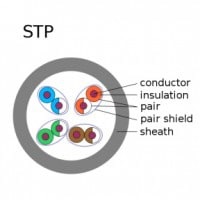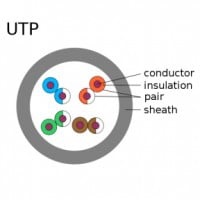Thin co-axial and thick co-axial cables have conductive grounding sheath surrounding the center conductor. Therefore, the electromagnetic interference (EMI) is significantly less.
Fiber optic cabling is immune to crosstalk and other electrical interference because optical fiber does not conduct electricity and uses light signals in a glass fiber, rather than electrical signals along a metallic conductor to transmit data. So it cannot produce a magnetic field and thus is immune to EMI.
In twisted pair cable, the noise introduced into the twisted pair wire is canceled as the electrical signals pass through the wire. However, it is not possible to reduce the electrical interference totally in a TP wire .Instead of transferring data over copper wires, these cables contain optical fibers that transmit data via light, rather than pulses of electricity. Each optical fiber is individually coated with plastic layers and contained in a protective tube, making it extremely resistant to external interference.
Twisted Pair cable Types:
STP stands for Shielded Twisted Pair and UTP stands for Unshielded Twisted Pair.
Comparison between STP and UDP
1. Physical: The only difference between the STP and UTP cable is the additional shielding material used in STP cables. The shielding covers the full length of the cable and protects it from any external interference.
2. Cost: Due to the additional material used in a STP cable, it costs more than the UTP cable.
3. Considerations: While using STP cable will yield maximum bandwidth despite external conditions, the shielding makes the cable heavier and more difficult to bend.
4. Use: UTP cable typically is used in homes and offices. Some large businesses also use the cable because it is cheaper. Large companies that require maximum bandwidth typically use STP cable. STP cable is used outside to better deal with the elements and equipment that may degrade bandwidth quality.
Shielded Twisted Pair (STP)cables reduce electrical noise and electromagnetic radiation. In other words, they help to keep the signal steady, and reduce interference with other devices. Given below is a diagram showing a typical shielded twisted pair cable

Unshielded Twisted Pair (UTP)cables do not have shielding to reduce interference. They are designed to cancel electromagnetic interference with the way the pairs are twisted inside the cable. Unshielded twisted cables are most widely used for office LANs, though recently wireless LANs are more widely used. Unshielded cables are lightweight, thin and flexible. They are also versatile and inexpensive. A typical UTP cable cross section is shown in the figure below:

CAT6 is rated for gigabit Ethernet while CAT6e is thicker and rated for 10 gig Ethernet. Typically CAT5e is sufficient and can also handle gig Ethernet, but noise margin will be less.
| CAT3 | CAT5 | CAT5e | CAT6 | CAT6e | CAT7 | |
|---|---|---|---|---|---|---|
| Speed | 16 Mbps | 100 Mbps | 1000 Mbps | 10/100/1000Mbps and 10 Gbps | 10/100/1000 Mbps and 10 Gbps |
10/100/1000 Mbps and 10 Gbps |
| Limitation | Ineffective for Higher - speed networks often found in older 10 BaseT networks | Range of 100 meters | Range of 100 meters | Range of 100 meters | Range of 100 meters | Range over 100 meters |
For connecting to an Ethernet LAN, you need an RJ-45 connector at the network end of the cable. The maximum allowed length of the cable for 1000BaseT Gigabit Ethernet is 100 meters (without repeater).
Cat 5e or better cable type is used for Gigabit Ethernet network cabling. Cat5e cable contains four twisted pairs of wires for Gigabit Ethernet
Category 3 - Used in 10BASE-T networks. Can transmit data at speeds up to 10 Mbps
Category 5 - Can transmit data at speeds up to 100 Mbps. Widely used in 100Base-T Ethernet networks.
Category 5e - Used in networks running at speeds up to 1000 Mbps (1 gigabit per second [Gbps]). The Cat-5e cable may be used in 1000BaseT Ethernet network. Both Cat -5 and 5e are almost same, except for better noise (cross talk, etc.) specs associated with 5e.
Category 6 cable, commonly referred to as Cat-6, is a cable standard for Gigabit Ethernet and other network protocols that is backward compatible with the Category 5/5e and Category 3 cable standards. The cable contains four twisted copper wire pairs. This is the same as CAT5 and CAT5e copper cable standards. The cable standard is suitable for 10BASE -T / 100BASE-TX and 1000BASE -T / 1000BASE-TX (Gigabit Ethernet).
The Category 7 cable standard has been created to allow 10 Gigabit Ethernet over 100 m of copper cabling. CAT 7 is backwards compatible with traditional Cat5 and Cat6 Ethernet. Cat7 offers strict specifications for crosstalk and system noise than Cat6. Shielding has been added for individual wire pairs on the Category 7 cable. Cat7 has been designed as a standard for Gigabit Ethernet over 100m of copper cabling The cable contains four twisted copper wire pairs, just like the earlier standards.
Note that RJ-11 connector has only two pairs of wires, and normally used for connecting telephones
IEEE 1394 cabling consists of shielded cable pairs. There are 4 and 6 wire versions of this cable type, known as STP, used in IEEE1394 connections.
IEEE 1394, High Performance Serial Bus, is an electronics standard for connecting devices to personal computer. IEEE 1394 provides a single plug-and-socket connection on which up to 63 devices can be attached with data transfer speeds up to 400Mbps(megabits per second).
FireWire is Apple's name for the IEEE 1394 High Speed Serial Bus.
A standard FireWire connection will support 100,200 and 400 Mbps.
The important features of IEEE1394 (also known as FireWire 400) are:
1. 100 Mbit/s, 200Mbit/s, and 400Mbit/s supported.
2. Works without control, devices communicate peer-to-peer.
3. Cable up to 4.5 m.
4. Up to 63 devices supported.
5. Power supply to external devices is 1.25A/12V (max.).
6. The only computer bus used in digital video cameras.
The IEEE 1394b specification supports data rates up to 400 Mbit/s in half-duplex mode, and even higher in full duplex. It can support optical connections up to 100 metres in length.
Power over Ethernet or PoE technologydescribes a system to pass electrical power safely, along with data, on Ethernet cabling. The IEEE standard for PoE requires category 5 cable or higher for high power levels, but can operate with category 3 cable if less power is required.
The System Preparation (Sysprep)tool prepares an installation of Windows for duplication, auditing, and customer delivery. Duplication, also called imaging, enables you to capture a customized Windows image that you can reuse throughout an organization. Audit mode enables you to add additional device drivers or applications to a Windows installation. After you install the additional drivers and applications, you can test the integrity of the Windows installation. Sysprep also enables you to prepare an image to be delivered to a customer. When the customer boots Windows, Windows Welcome starts.
RG-6 may be used for both analog and digital television transmission.
RG-59 is a specific type of coaxial cable, often used for low-power video and RF signal connections
Comparison between RG-6 and RG-59
1. RG6 cable has a thicker conductor than the RG59
2. RG6 cable has better insulation than the RG59
3. RG6 can carry signals of much higher frequencies than the RG59
4. RG6 has much lower signal losses compared to the RG59
5. RG6 cable may not operate below 50Mhz while the RG59 can
6. RG6 is better for satellite signals while RG59 is better for video signals
7. RG6 cables cost more than RG59

